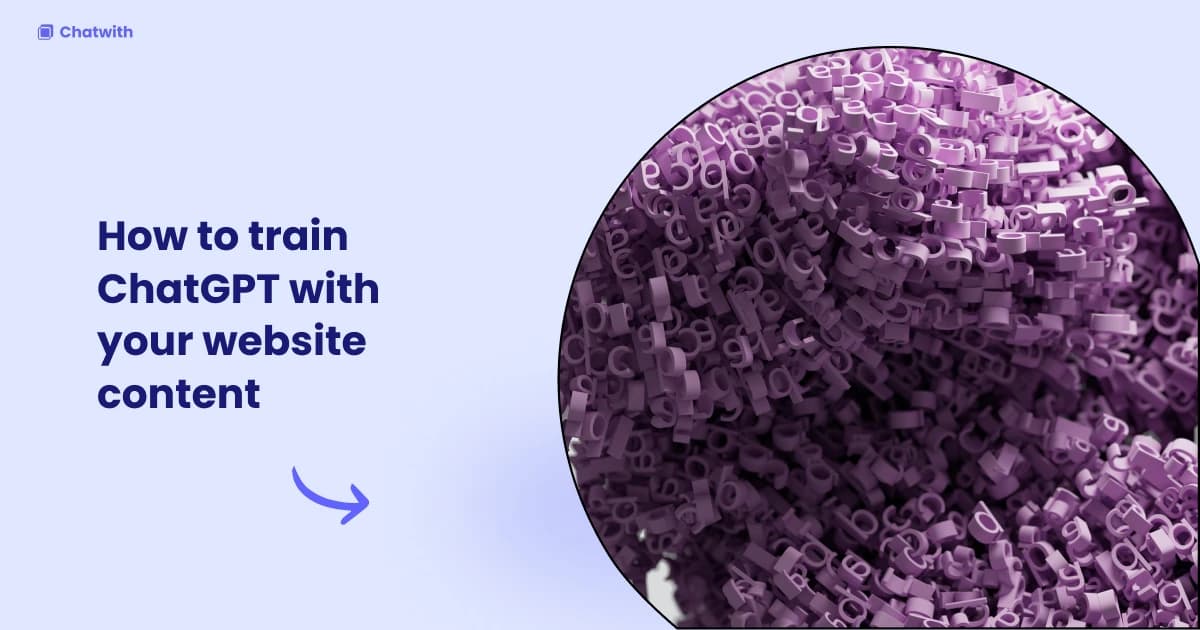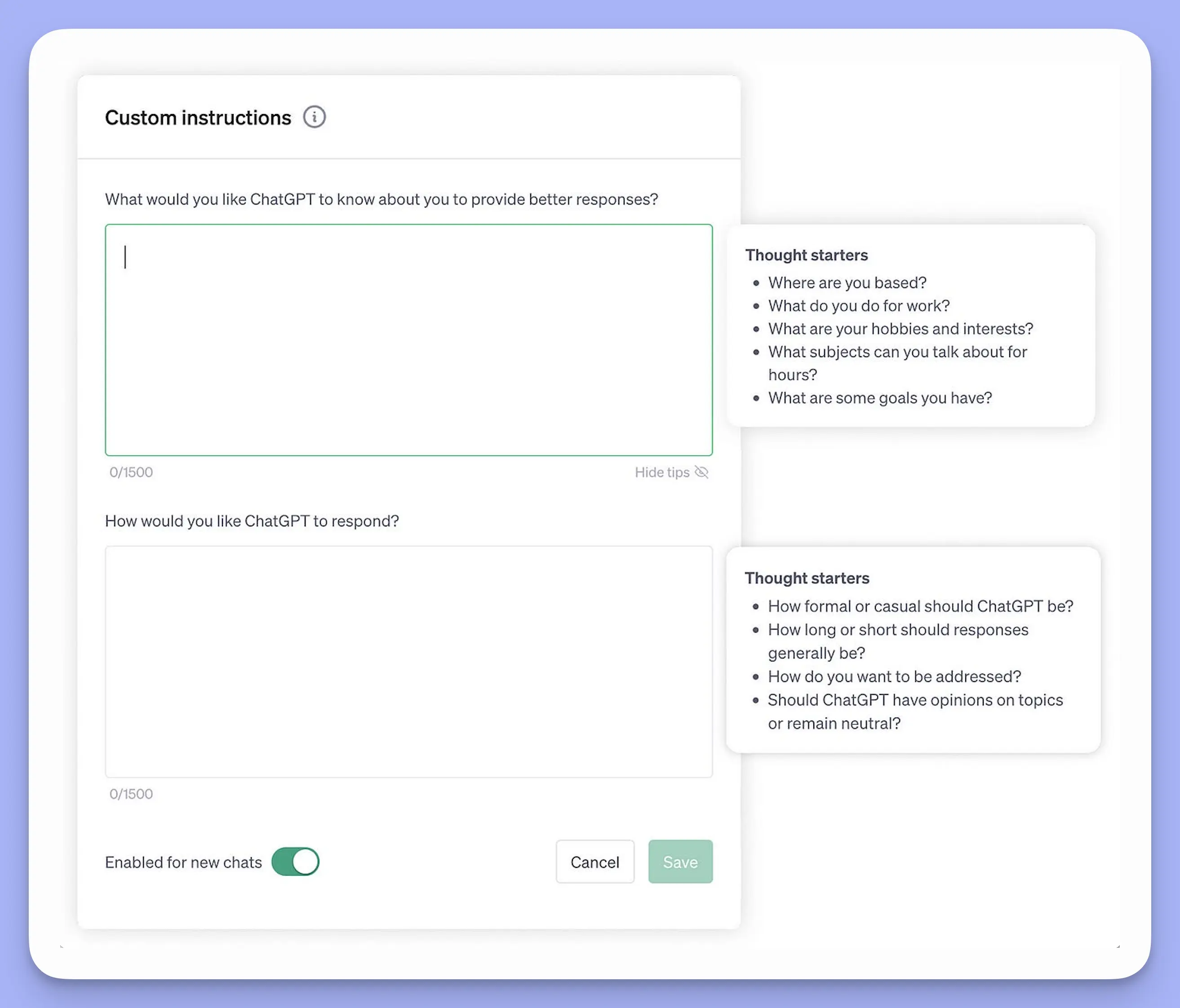
Founder of Chatwith
How to train ChatGPT on your data and build a custom AI chatbot
In today's digital era, artificial intelligence is reshaping how we interact with customers. Chatbots, driven by AI, are becoming an essential part of online strategy. Among them, ChatGPT stands out. It's an AI language model that can converse with users in a way that feels natural and human-like. This makes it a valuable tool in customer service, marketing, and more.
What's interesting is that you can train your chatbot so it has additional context and understanding of your business or other data. In this article, we'll guide you on how to achieve this using a variety of approaches. Let's get started!
What is ChatGPT and why you need a custom-trained AI chatbot
ChatGPT, a Generative Pretrained Transformer (GPT), is revolutionizing the way we think about AI chatbots. Beyond just handling customer service, these AI tools can be customized to perform a variety of tasks. By training ChatGPT with your specific data, you can create a chatbot that understands your business deeply. This customization allows for more accurate responses, making every user interaction more meaningful and efficient. ChatGPT can be integrated into various platforms such as websites, apps, and messaging services to provide instant customer support, answer frequently asked questions, recommend products, and more. Its natural language processing capabilities enable it to have conversations with users in a human-like manner, improving user engagement and satisfaction.
Different ways to train ChatGPT on your own data
Training custom AI models like ChatGPT offers flexibility in how you can approach the task. One easy choice is to use ChatGPT Pro to create a Custom GPT with limited access to additional data. For those who enjoy coding, creating a custom AI using Python and the ChatGPT API is a rewarding challenge. Alternatively, no-code platforms offer a user-friendly interface for those not familiar with programming.
1. Creating custom chatbots using Python and OpenAI API
Building a custom chatbot in Python offers a hands-on approach to AI development. After installing Python libraries, leverage essential tools, OpenAI API and vector databases to start building your chatbot. This method gives you full control over the training process, allowing you to implement complex logic and integrate various data sources seamlessly. The result can be a highly customized chatbot, but it requires access to OpenAI API key, technical skills or the help of an experienced software developer who can build your custom chatbot.
2. Using Custom Instructions in ChatGPT Plus
With a ChatGPT Plus subscription, personalizing your AI chatbot's responses can be done using Custom Instructions feature. This feature allows you to define the writing style and tone of your chatbot's replies and to provide it with a bit of extra information. You can add these instructions by clicking on "Custom Instructions" in your ChatGPT web interface and entering the text. This approach has a limitation on the amount of information that can be entered and unfortunately applies to all your interactions with ChatGPT - so you're stuck with just one personalized AI.

3. Creating a custom GPT using ChatGPT Plus
If you are a premium subscriber to ChatGPT Plus, you can create your own version of ChatGPT known as Custom GPT. This version is essentially a ChatGPT chatbot that can access additional text files and offers the ability to utilize a more sophisticated prompt. You have the freedom to create multiple GPTs, each tailored for a particular task. However, the benefits stop there, as this type of chatbot lacks the capability for visual customization, cannot be embedded on a website, and is unable to interact with extensive amounts of data or your website's content.
4. Using a no-code AI chatbot builder
For those looking for a simpler route, no-code chatbot builders are a perfect choice. These platforms offer an intuitive interface to train ChatGPT on your custom data without writing a single line of code. By selecting this option, you can focus more on the strategic aspects, like defining the chatbot's objectives and fine-tuning its responses. This approach is ideal for businesses seeking to quickly deploy a chatbot with ChatGPT's capabilities, without the need for technical expertise.
How to train your ChatGPT on custom data using a chatbot builder
Utilizing a chatbot builder to train ChatGPT on your custom data simplifies the process significantly. Start by preparing your training data, ensuring it covers the pain points and scenarios you want the chatbot to address. Next, use a chatbot builder like Chatwith that lets you create an advanced chatbot with a few clicks.
Chatwith is designed to make AI approachable for everyone. It lets you train ChatGPT using data from your website, files, and even YouTube videos, without getting into the technicalities. With Chatwith, you just upload your data then use this data to train ChatGPT, creating a model that grasps your specific context.
Go beyond just basic training for your custom chatbot
Here's another perk of using chatbot builders: you gain access to plethora of useful features not available in simple tools like Custom GPTs, or which would take forever to build if programmed by hand.
Customizing ChatGPT with your branding
Customizing ChatGPT to reflect your brand identity is crucial for maintaining consistency across customer interactions. By incorporating your company's tone, style, and knowledge base, you create a virtual assistant that not only understands your business inside out but also communicates with customers in a way that's uniquely you. This level of personalization strengthens your brand's presence and enhances the overall customer experience.
Adding custom Actions
Custom Actions are a way to extend the functionality of ChatGPT models by interacting with the outside world. By integrating external services, chatbots can perform a wide range of tasks, such as retrieving information from databases, sending emails, or even acting as shopping assistants. This opens up a world of possibilities for creating chatbots that can provide valuable and personalized interactions to users and automate processes in business environments.
Integrating ChatGPT with Slack and messaging platforms
Expanding ChatGPT's utility across various platforms like Slack transforms it into a versatile tool for your team. With simple integration steps, anyone in your organization can interact with the chatbot. This means your custom-trained ChatGPT can assist with inquiries, streamline tasks, and facilitate smoother communication within platforms your team already uses, making it an invaluable asset. You can also integrate your chatbot in messaging services like WhatsApp, making it available where your customers are.
Installing a custom AI chatbot on your website
Once your custom-trained ChatGPT is ready, you can add your chatbot to your website. This allows your visitors to chat with your AI directly, getting their queries resolved promptly. This not only enhances the user experience but also allows your team to concentrate on other crucial tasks. By automating the response to common questions, you can notably decrease your customer service efforts.
Final word
It's time to train a custom ChatGPT! The chatbot lets you deliver personalized experiences and efficient, impactful customer support. With the option to create your own custom responses and train your AI using your own data, the possibilities are truly endless. And with platforms like Chatwith, leveraging AI's potential is now straightforward. So, why delay? Embark on your AI adventure now and offer your visitors a memorable customer experience. And always remember, if you need assistance or have questions, we're here to support you. Enjoy your AI training journey!
More from our blog
Hunted Space and a custom AI for the Product Hunt launch tracker
Learn how Hunted Space has created a custom AI chatbot that connects to their API and engages visitors with trivia about current Product Hunt launches.
How OpenAPI Actions can make a custom GPT more powerful
Explore how Actions with OpenAPI can make custom GPT chatbots more capable, enabling them to access external data and automate tasks.

